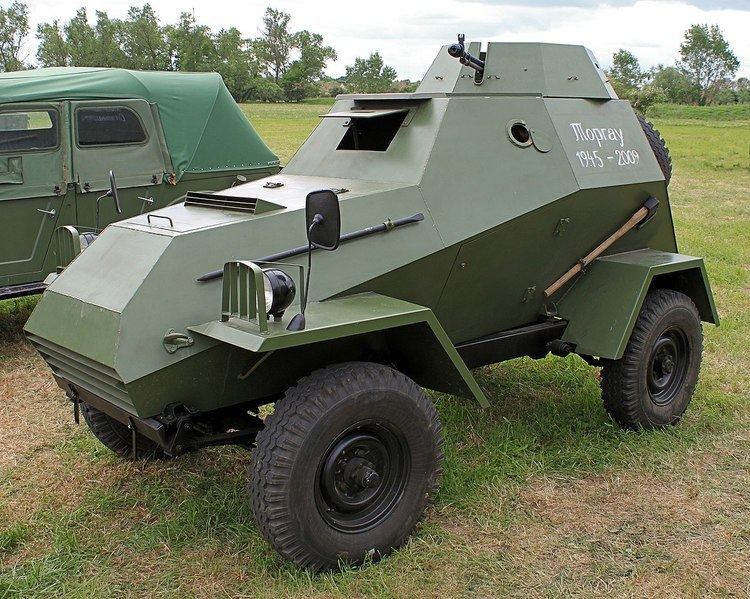Type Armoured car In service 1942–1950s (USSR) Designer Vitaliy Grachev | Used by various | |
 | ||
Wars | ||
The BA-64 is a small, lightly armoured, four-wheeled Soviet scout car based on the GAZ-64, the independently developed Soviet equivalent to the American Jeep. It typically carried a Degtyaryov machine gun or PTRD anti-tank rifle. Nicknamed Bobik (a popular dog name/nickname) by Red Army crews, the vehicle has been widely exported. The majority of GAZ-64 chassis produced during World War II were used for BA-64 armored cars.
Contents
The total recorded number of BA-64s produced differs even in Russian sources. The most frequently stated figures are 9,110 (3,901 BA-64 and 5,209 BA-64B) vehicles which were built in the GAZ automobile plant, although a memorial plaque near the pictured Nizhny Novgorod car states 9,063 cars. The Red Army representatives accepted only 8,174 BA-64s, including 3,390 with radio sets; the other vehicles were transferred to NKVD units and Soviet allies. BA-64 inspired other military vehicles such as SK-1
Production history
The BA-64 armoured car was a construction initiative of GAZ chief designer V. A. Grachev. Design work started on July 17, 1941. The designer's team also included F. A. Lependin (general layout), G. M. Wassermann (leading engineer), Yu. N. Sorochkin, B. T. Komarevskiy, V. F. Samoilov (armoured hull) and others. On April 10, 1942, Grachev was awarded the Third Grade Stalin Prize for creation of the BA-64 armoured car and GAZ-61 light utility vehicle. The GAZ-64 appears superficially similar to the American Jeep, but was derived from a 1940 Soviet requirement from experience in Finland, and was independently developed.
The majority of the GAZ-64 chassis produced during World War II were used for the BA-64 armored car, due to the availability of Lend Lease Jeeps to fill the non-combat role of the GAZ-64. Due to GAZ-64 production being tied to BA-64 production during the war, very few GAZ-64 were actually produced during the war.
The initial BA-64 model was based on the GAZ-64 and fitted with sloped armour that had some similarities to the German Sd kfz 222 design. One captured Sd Kfz 222 was transferred to GAZ for examination and analysis on September 7, 1941. The first prototype was tested on January 9, 1942. The hull had many resemblances with sdkfz-234 basic shape, and it had an open roof, with a pintle-mounted 7.62mm DT machine gun. The vehicle was operated by a crew of two. The next day the BA-64 prototype was shown to Kliment Voroshilov. The official presentation was in the Kremlin on March 3, 1942. The State Defence Committee adopted the BA-64 for Red Army service on March 14, 1942. It was top-heavy and could easily overturn on rough terrain.
The improved BA-64B model was introduced in 1943, based on the GAZ-67B, with a wider wheelbase. This model also had a small machine-gun turret added. The mass production of BA-64Bs continued through the rest of the Second World War and ceased in 1946. The last 62 vehicles were completed in that year.
BA-64Bs were also used by Polish and Czech units, raised in Soviet Union. After the end of the war, some BA-64Bs were transferred to the police of the GDR. There were other post-war transfers of BA-64Bs to North Korea, China and Yugoslavia.
Variants
Combat history
The major drawback of the BA-64 was its light armament. However, BA-64s were used successfully in reconnaissance and liaison missions. One benefit was the high elevation angle of the DT machine gun. Together with the vehicle's high speed and good manoeuvrability, this made BA-64s successful in urban combat against enemy infantry on the upper floors of buildings. In addition, the high-angle traverse of the DT machine gun could be used to engage enemy aircraft, although the weapons fitted lacked adequate firepower for this.
